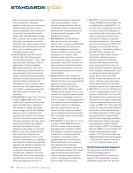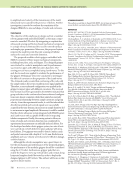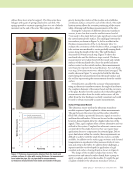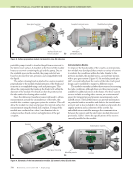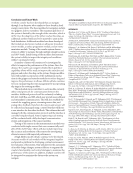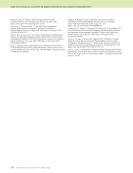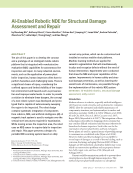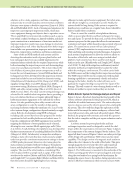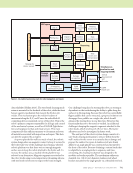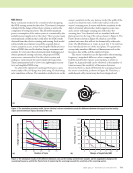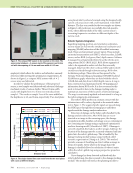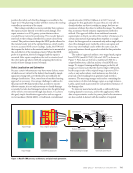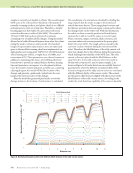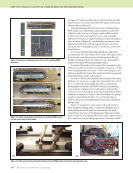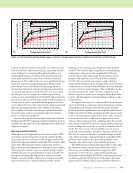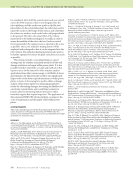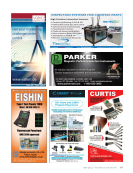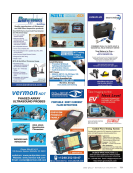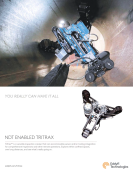J U L Y 2 0 2 1 • M A T E R I A L S E V A L U A T I O N 749 is about 1.5 kN and 2 kN lower than the case of 20 mm/min, with and without induction preheating, respectively. Further- more, in Figure 13, comparing the peak vertical force at a certain plunge speed, it is observed that the reduction rate of the peak vertical force slows down with the decrease of plunge speed. This might be due to a more significant temper- ature drop caused by a longer plunge time. But the lowest peak vertical force is still obtained at the plunge speed of 0.5 mm/min. Maximum reduction in the peak vertical force occurs at the plunge speed of 20 mm/min in all cases. Take the 500 rpm case for example: the additional preheating assists to reduce the plunge force by 0.64 kN with a reduction rate of about 12% at 0.5 mm/min, and by 1.46 kN and 20% at 20 mm/min. It can be concluded that the peak vertical force can be efficiently reduced by optimizing the plunge speed and induction heating parameters, and a smaller peak vertical force could be obtained if continuing to optimize the induc- tion parameters, such as increasing the induction heating power or induction heating time. Based on the results mentioned previously, the induction- heating assisted FSW technique would potentially be the best candidate for the repair of cracks with improved mobility and longevity of repairs. Discussion and Conclusion Although this novel approach for autonomous robotic NDE and repair is proposed and demonstrated using the prelimi- nary results, there are still many technical gaps existing with further development desired to make this CPS system feasible in the field. The first improvement requires the need for a large-scale data set of representative damages for power plant boiler inspection, which requires an extremely large number of NDE data sets for training. Relative to what is possible for this report, obtaining this large number of data sets is not feasible, nor is the number of data sets to achieve a properly trained system known. Another drawback of this current technique is the computational complexity of the R-CNN method. This method requires significant overhead during training due to the need to run an individual CNN over various regions of the same image. There has been recent progress with methods such as Fast R-CNN and Faster R-CNN. These methods only require a single CNN per image, which would hasten the training of the model. Another consideration is to automatically determine if certain damages are more critical to system integrity. This would allow for the system to prioritize the repair of certain components and therefore optimize maintenance strategies. Methods for false positive and false negative errors for damage analysis are also considerations. Having the robot query for online feedback from a human expert should help in addressing repair prioritization and false determinations of damages however, the need for human feedback should be minimized as the model should learn and build upon itself to be fully automated. Another major consid- eration is that many power plant boiler house walls consist of an array of water tubes in addition to simple uniform steel surfaces. These surfaces present a challenge given the nonuni- form distance of the NDE coil array, which results in distorted sensor readings that cannot be accurately evaluated by the AI model. The last concern is the possibility of a scan along a crack that occurs parallel to the robot’s direction of travel. In this case, the sensor would detect a minimal change in unifor- mity, which may lead to damage being left unclassified. This problem may be addressed by performing multiple scans along the same surface but in perpendicular directions. The FSW process preliminarily repaired the cracks on the flat steel plate surface, and the weld without any surface defects was successfully obtained by using proper FSW parameters. This work has a certain guiding significance, which shows the feasibility of FSW for crack repair. However, in order to apply the robotic repair technology to the crack repair on the real boiler surface, some problems still need to 4.0 0 2 4 6 8 10 Plunge speed (mm/min) 12 14 16 18 20 4.5 5.0 5.5 6.0 6.5 7.0 7.5 8.0 8.5 500 rpm, without induction heating 500 rpm, with induction heating 4.0 0 2 4 6 8 10 Plunge speed (mm/min) 12 14 16 18 20 4.5 5.0 5.5 6.0 6.5 7.0 7.5 8.0 8.5 400 rpm, without induction heating 400 rpm, with induction heating 20% force reduction Figure 13. Peak vertical force during plunge stage as a function of plunge speed under the conditions of: (a) 400 rpm and (b) 500 rpm. (a) (b) Maximum vertical force (kN) Maximum vertical force (kN)
750 M A T E R I A L S E V A L U A T I O N • J U L Y 2 0 2 1 be considered. First of all, the current repair work was carried out on the FSW machine, which is not integrated into the robot platform, and the cracks were made on the flat steel plate surface. In the actual boiler plant, the robot may need to repair the cracks on the bumpy boiler surface, and sometimes the robot even needs to work on the boiler wall perpendicular to the ground. Therefore, the actual effect of the robotic repair needs to be further investigated. Secondly, in order to ensure the mobility of the robot, the load (such as vertical force) generated in the repair process is expected to be as low as possible. Hence, the induction heating system will be employed and redesigned so that it can be integrated into the robot system. The induction heating parameters also need to be further optimized to reduce the peak vertical force as much as possible. This system provides a conceptual design as a good starting point for a further automated system for boiler wall damage evaluation and repair within power plants. It is also possible to further extend the concepts and methods in this report to use a similar system for other structure analysis applications from other various energy or civil fields. A closer approximation for full autonomy would in turn significantly improve the results from required maintenance within power plants, in terms of decreasing time used to obtain a damage analysis of the system under test, enhancing quantitative results for objectifying damages, decreasing the likelihood of cataclysmic system failure, and overall improvements in human safety by minimizing human interaction within hazardous regions that require inspection. The application of this automated NDE CPS robotic platform can improve the costs of maintenance and the quality of life within power plants. ACKNOWLEDGMENTS This work is partially supported by the National Energy Technology Labo- ratory, Department of Energy with Award No. DE-FE0031650. The authors are also thankful to the technical services provided by Brian Wright at the MSU ECE Machine Shop. REFERENCE Albawi, S., T.A. Mohammed, and S. Al-Zawi, 2017, “Understanding of a Convolutional Neural Network,” 2017 International Conference on Engi- neering and Technology (ICET), pp. 1–6, https://doi.org/10.1109/ICEng Technol.2017.8308186 Ali, M.S., and H. Habibullah, 2019, “A Review on the Current Status of Boiler Inspection and Safety Issues in Bangladesh,” Energy Procedia, Vol. 160, pp. 614–620, https://doi.org/10.1016/j.egypro.2019.02.213 Ali, R., and Y.-J. Cha, 2019, “Subsurface Damage Detection of a Steel Bridge Using Deep Learning and Uncooled Micro-Bolometer,” Construction and Building Materials, Vol. 226, pp. 376–387, https://doi.org/10.1016/j.conbuildmat.2019.07.293 Baba, T., S. Harada, H. Asano, K. Sugimoto, N. Takenaka, and K. Mochiki, 2009, “Nondestructive Inspection for Boiling Flow in Plate Heat Exchanger by Neutron Radiography,” Nuclear Instruments and Methods in Physics Research Section A: Accelerators, Spectrometers, Detectors and Associated Equipment, Vol. 605, Nos. 1–2, pp. 142–145, https://doi.org /10.1016/j.nima.2009.01.140 Bogue, R., 2010, “The Role of Robotics in Non‐destructive Testing,” Industrial Robot, Vol. 37, No. 5, pp. 421–426, https://doi.org/10.1108 /01439911011063236 Byers, L., J. Friedrich, R. Hennig, A. Kressig, X. Li, C. McCormick, and L. Malaguzzi Valeri, 2018, “A Global Database of Power Plants,” World Resources Institute, available at https://www.wri.org/research /global-database-power-plants Caccamo, S., R. Parasuraman, L. Freda, M. Gianna, and P. Ögren, 2017, “RCAMP: A Resilient Communication-Aware Motion Planner for Mobile Robots with Autonomous Repair of Wireless Connectivity,” 2017 IEEE/RSJ International Conference on Intelligent Robots and Systems (IROS), pp. 2010–2017, https://doi.org/10.1109/IROS.2017.8206020 Cui, L., H. Fujii, N. Tsuji, K. Nakata, K. Nogi, R. Ikeda, and M. Matsushita, 2007, “Transformation in Stir Zone of Friction Stir Welded Carbon Steels with Different Carbon Contents,” ISIJ International, Vol. 47, No. 2, pp. 299–306, https://doi.org/10.2355/isijinternational.47.299 De, A., H.K.D.H. Bhadeshia, and T. DebRoy, 2014, “Friction Stir Welding of Mild Steel: Tool Durability and Steel Microstructure,” Materials Science and Technology, Vol. 30, No. 9, pp. 1050–1056, https://doi.org /10.1179/1743284714Y.0000000534 Ghosh, M., K. Kumar, and R.S. Mishra, 2011, “Friction Stir Lap Welded Advanced High Strength Steels: Microstructure and Mechanical Proper- ties,” Materials Science and Engineering: A, Vol. 528, No. 28, pp. 8111–8119, http://doi.org/10.1016/j.msea.2011.06.087 Gibb, S., H.M. La, T. Le, L. Nguyen, R. Schmid, and H. Pham, 2018, “Nondestructive Evaluation Sensor Fusion with Autonomous Robotic System for Civil Infrastructure Inspection,” Journal of Field Robotics, Vol. 35, No. 6, pp. 988–1004, https://doi.org/10.1002/rob.21791 He, K., G. Gkioxari, P. Dollár, and R. Girshick, 2017, “Mask R-CNN,” 2017 IEEE International Conference on Computer Vision (ICCV), pp. 2980–2988, https://doi.org/10.1109/ICCV.2017.322 Hellier, C., 2013, Handbook of Nondestructive Evaluation, 2nd ed., McGraw Hill Kharkovsky, S., and R. Zoughi, 2007, “Microwave and Millimeter Wave Nondestructive Testing and Evaluation – Overview and Recent Advances,” IEEE Instrumentation & Measurement Magazine, Vol. 10, No. 2, pp. 26–38, https://doi.org/10.1109/MIM.2007.364985 Korhonen, I., and J. Ahola, 2018, “Microwave Attenuation in Kraft Recovery Boiler,” IET Microwaves, Antennas & Propagation, Vol. 12, No. 2, pp. 241–245, https://doi.org/10.1049/iet-map.2017.0263 Kumar, D., S. Karuppuswami, Y. Deng, and P. Chahal, 2018, “A Wireless Shortwave Near-Field Probe for Monitoring Structural Integrity of Dielectric Composites and Polymers,” NDT & E International, Vol. 96, pp. 9–17, https://doi.org/10.1016/j.ndteint.2018.02.005 Lian, G., Y. Niu, X. Zhang, Y. Lu, and H. Li, 2018, “Analysis of Causes of Boiler Accidents in Power Plant and Accident Handling Based on Mathe- matical Statistics,” 2018 International Conference on Engineering Simulation and Intelligent Control (ESAIC), pp. 17–20, https://doi.org/10.1109 /ESAIC.2018.00012 Lienert, T.J., W.L. Stellwag, Jr., B.B. Grimmett, and R.W. Warke, 2003, “Friction Stir Welding Studies on Mild Steel,” Supplement to Welding Journal, pp. 1-S–9-S Liu, Y., A. Xie, D. Shen, and X. Yang, 2020, “Eddy Current Testing in Service of the Boiler Heating Surface Tube Elbow in Thermal Power Plants,” IOP Conference Series: Earth and Environmental Science, Vol. 585, https://doi.org/10.1088/1755-1315/585/1/012120 Ma, Z.Y., 2008, “Friction Stir Processing Technology: A Review,” Metallurgical and Materials Transactions A, Vol. 39, pp. 642–658, https://doi.org/10.1007/s11661-007-9459-0 Mandeliya, M., and M. Vishwakarma, 2018, “A Review on Boiler Tube Assessment in Power Plant Using Ultrasonic Testing,” International Research Journal of Engineering and Technology (IRJET), Vol. 5, No. 6, pp. 708–714 ME TECHNICAL PAPER w ai-enabled robotic nde for structural damage
ASNT grants non-exclusive, non-transferable license of this material to . All rights reserved. © ASNT 2025. To report unauthorized use, contact: customersupport@asnt.org



























































